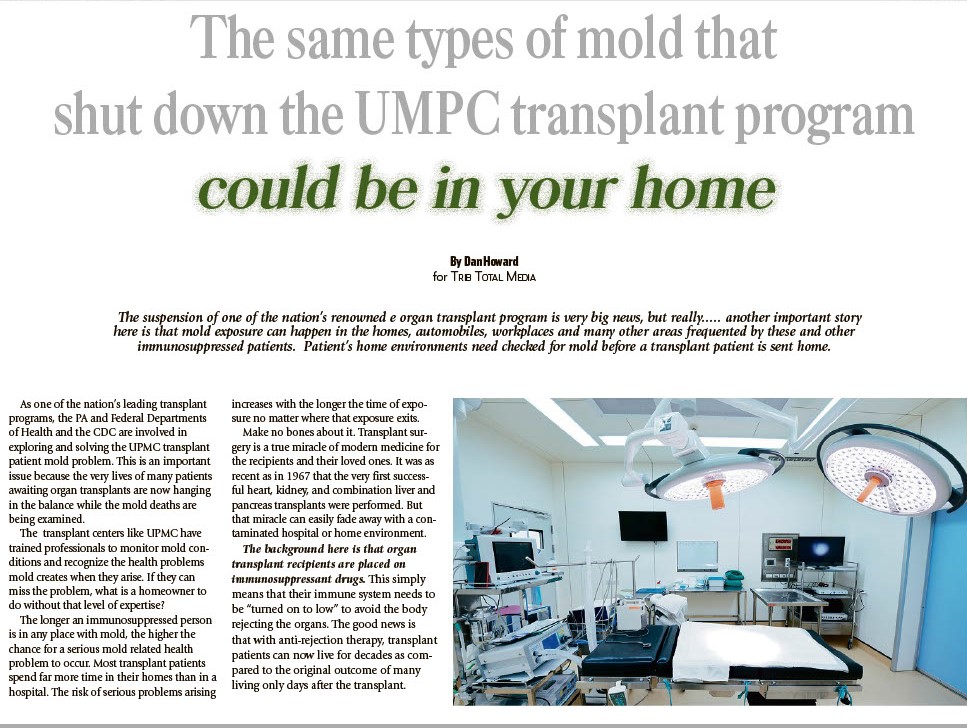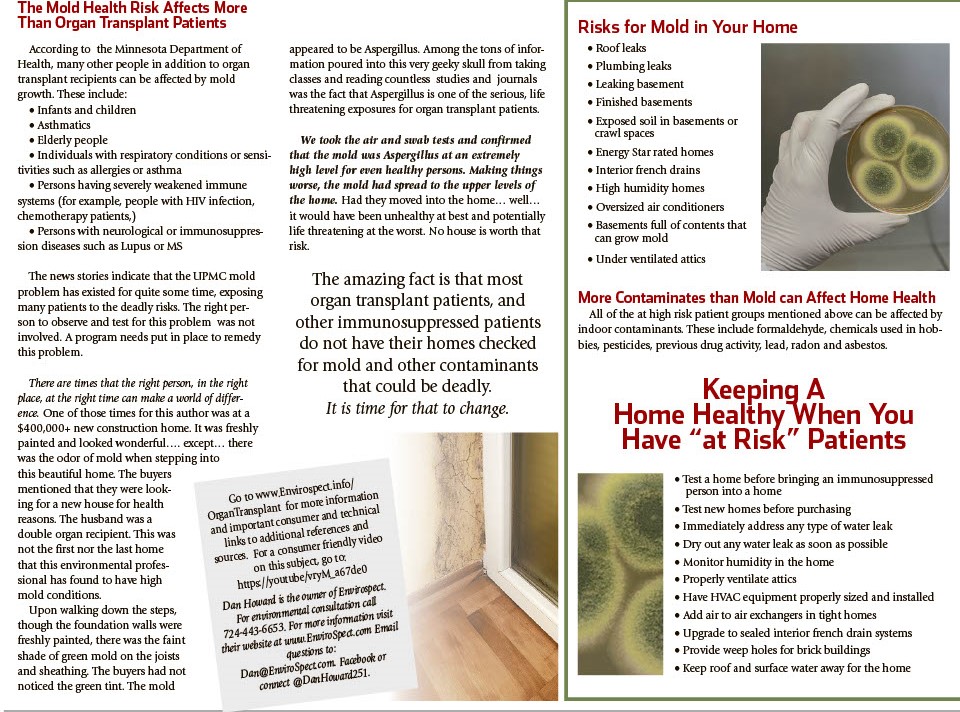Click here to download Mold and Organ Transplant Patients Article as a PDF

 Mold Exposure Can be Deadly for Organ Transplant Patients Returning Home Post Transplant
Mold Exposure Can be Deadly for Organ Transplant Patients Returning Home Post Transplant
The suspension of one of the nation's renowned organ transplant program is very big news, but really..... another important story here is that mold exposure can happen in the homes, automobiles, workplaces and many other areas frequented by these and other immuno-suppressed patients. Patient's home environments need checked for mold before a transplant patient is sent home.
As one of the nation's leading transplant programs, the PA and Federal Departments of Health and the CDC are involved in exploring and solving the UPMC transplant patient mold problem. This is an important issue because the very lives of many patients awaiting organ transplants are now hanging in the wind while the mold deaths are being examined.
The transplant centers like UPMC have trained professionals to monitor mold conditions and recognize the health problems mold creates when they arise. If they can miss the problem, what is a homeowner to do without that level of expertise?
The longer an immunosuppressed person is in any place with mold, the higher the chance for a serious mold related health problem to occur. Most transplant patients spend far more time in their homes than in a hospital. The risk of serious problems arising increases with the longer the time of exposure no matter where that exposure exits.
Make no bones about it. Transplant surgery is a true miracle of modern medicine for the recipients and their loved ones. It was as recent as in 1967 that the very first successful heart, kidney, and combination liver and pancreas transplants were performed. But that miracle can fade away because of the either the hospital or the home environment.
The background here is that organ transplant recipients are placed on immunosuppressant drugs. This simply means that their immune system needs to be “turned on to low” to avoid the body rejecting the organs. The good news is that with anti-rejection therapy, transplant patients can now live for decades as compared to the original outcome of many living only days after the transplant.
The Mold Health Risk Affects More Than Organ Transplant Patients
According to the Minnesota Department of Health, many other people in addition to organ transplant recipients can be affected by mold growth. These include:
- Infants and children
- Asthmatics
- Elderly people
- Individuals with respiratory conditions or sensitivities such as allergies or asthma
- Persons having severely weakened immune systems (for example, people with HIV infection, chemotherapy patients,)
- Persons with neurological or immunosuppression diseases such as Lupus or MS
The news stories indicate that the UPMC mold problem, has existed for quite some time, exposing many patients to the deadly risks. The right person to observe and test for the problem was not involved. It needs to be a program in place.
There are times that each of us can be in the right place at the right time.
One of those times for this author was a $ 400,000+ new construction home. It was freshly painted and looked wonderful….except …there was the odor of mold when stepping into this beautiful home. This was not the first or last home with transplant patients as potential residents that this environmental professional has found with high mold conditions. The buyers mentioned that they were looking for a new house for health reasons. The husband was a double organ recipient.
Upon walking down the steps, though the foundation walls were freshly painted, there was the faint green shade of green mold on the joists and sheathing. The buyers had not noticed the green tint. The mold appeared to be Aspergillus. Among the tons of information poured into this very geeky skull from sitting in tons of classes and reading studies and journals was the fact that Aspergillus is one of the serious, life threatening exposures for organ transplant patients.
We took the air and swab tests and confirmed that the mold was Aspergillus at an extremely high level for even healthy persons. Making things worse, the mold had spread to the upper levels of the home. Had they moved into the home…well….it would have been unhealthy at best and potentially life threatening. No house is worth that risk.
The amazing fact is that most organ transplant patients, and other immunosuppressed patients do not have their homes checked for mold and other contaminants that could be deadly. It is time for that to change.
For a consumer friendly video on this subject, go to: https://youtu.be/vryM_a67de0
The CDC has one of the most readable information sheets on this subject:
http://www.cdc.gov/fungal/infections/organ-transplant.html
OTHER GOOD LINKS
http://cid.oxfordjournals.org/content/37/2/221.full.pdf
http://emedicine.medscape.com/article/430550-overview
http://wwwnc.cdc.gov/eid/article/17/10/11-0087_intro.htm
http://pats.atsjournals.org/content/3/1/35.full
Invasive mold infections in solid organ transplant recipients.
Mold Infections in Solid Organ Transplant Recipients.
IL1B and DEFB1 Polymorphisms Increase Susceptibility to Invasive Mold Infection After Solid-Organ Transplantation.
Fungi and molds following lung transplantation.
Invasive non-Aspergillus mold infections in transplant recipients, United States, 2001-2006.
PTX3 Polymorphisms and Invasive Mold Infections After Solid Organ Transplant.
Invasive fungal infections in transplant recipients
Epidemiology, outcomes, and mortality predictors of invasive mold infections among transplant recipients: a 10-year, single-center experience.